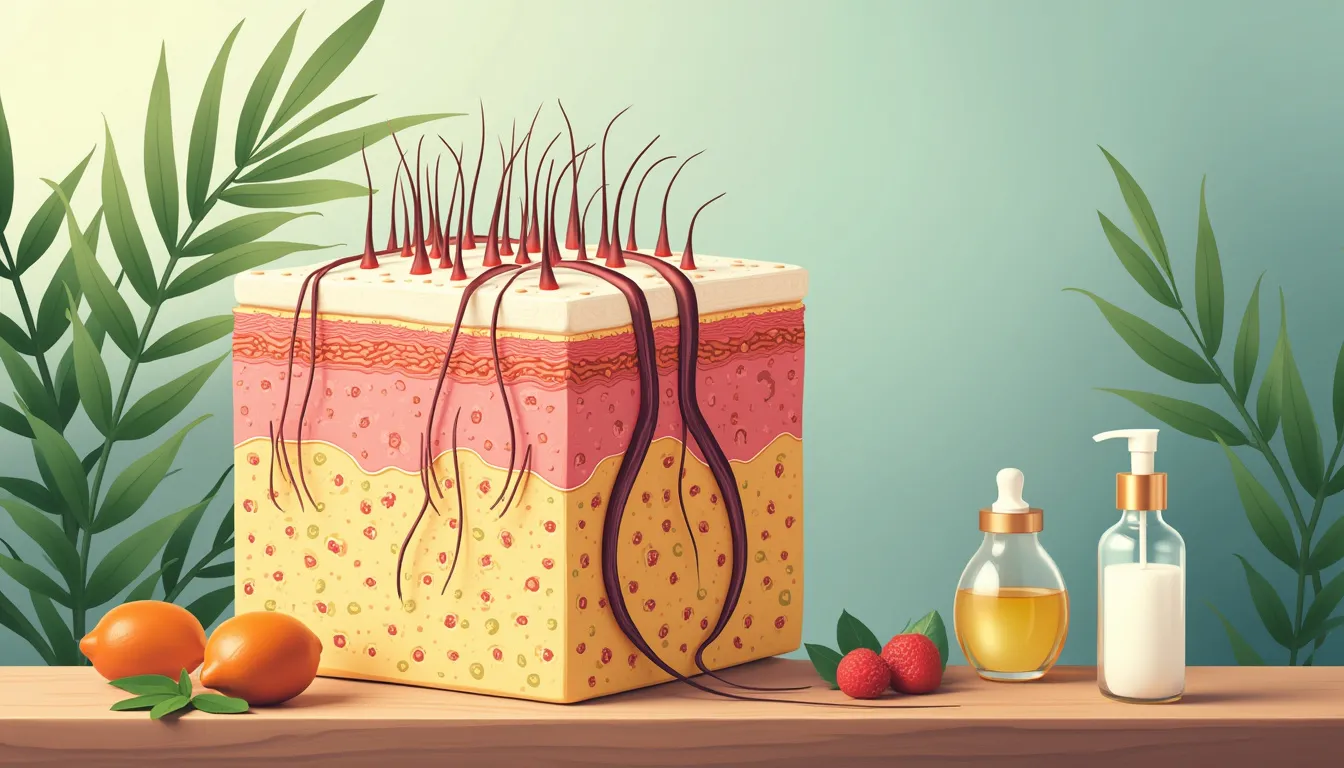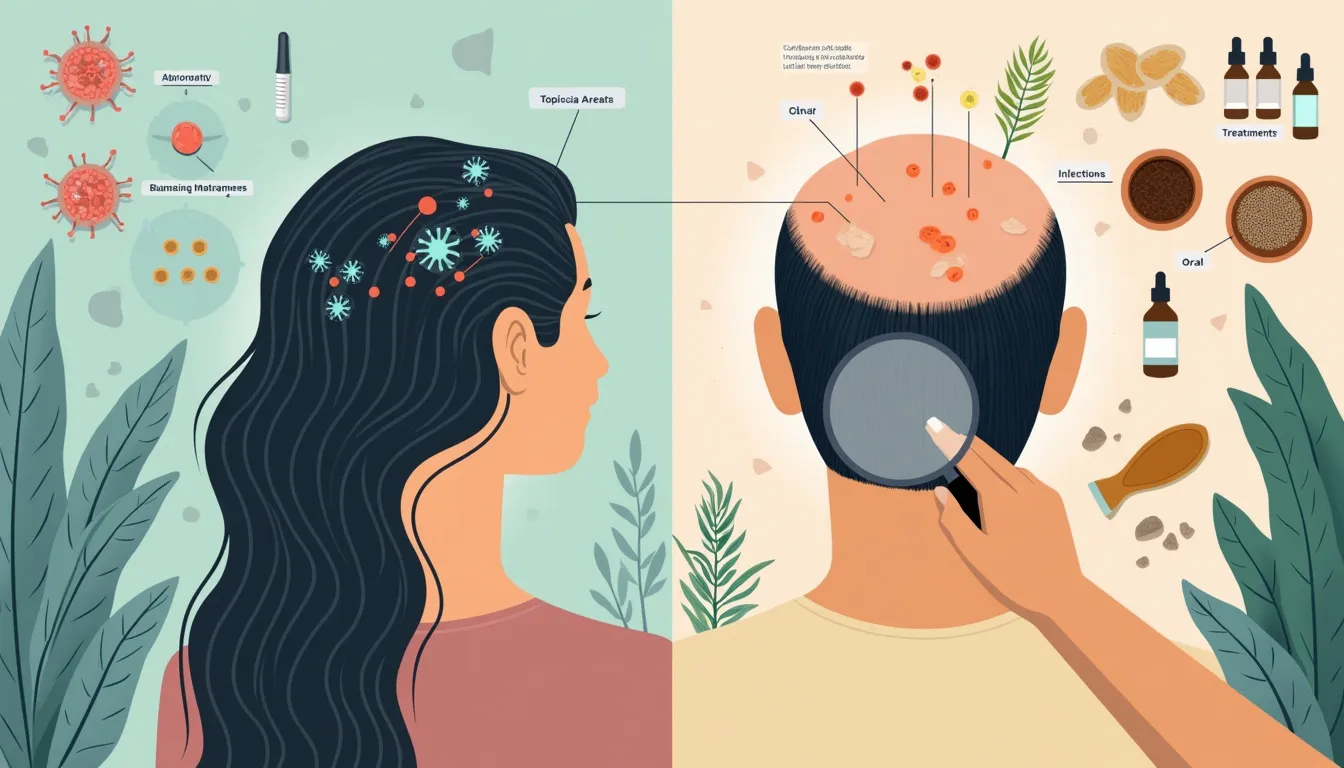Have you ever noticed clumps of hair on your pillow or circular bald patches on your scalp? You might be experiencing alopecia areata, a mysterious and often misunderstood autoimmune condition that affects millions worldwide. While hair loss can be distressing, understanding alopecia areata is the first step towards managing this condition effectively. In this comprehensive guide, we’ll delve into the intricacies of alopecia areata, exploring its causes, symptoms, and the various treatment options available. Whether you’re personally affected by this condition or simply curious about hair loss disorders, this article will provide valuable insights into the world of alopecia areata. From patchy hair loss to complete baldness, we’ll uncover the different types of this condition and discuss the latest research on its origins. Join us as we unravel the complexities of alopecia areata and discover how individuals can regain control over their hair health and confidence.
What is Alopecia Areata?
Alopecia areata is a complex autoimmune condition that affects millions of people worldwide, causing unpredictable hair loss. This fascinating yet challenging disorder has puzzled medical professionals and researchers for decades, leaving many individuals searching for answers and effective treatments.
Definition and Overview of Alopecia Areata
At its core, alopecia areata is an autoimmune disorder where the body’s immune system mistakenly attacks hair follicles, leading to hair loss. The term alopecia comes from the Greek word for fox, alluding to the patchy fur loss often seen in foxes with mange. Areata means in patches, describing the characteristic pattern of hair loss associated with this condition.
Unlike some other forms of hair loss, alopecia areata is not contagious, nor is it directly caused by stress, though stress may trigger or exacerbate episodes in some individuals. The condition can affect anyone, regardless of age, gender, or ethnicity, though it often first appears during childhood or early adulthood.
One of the most perplexing aspects of alopecia areata is its unpredictable nature. Hair loss can occur suddenly, often in circular patches about the size of a quarter. For some, the hair may regrow spontaneously, while for others, the condition may progress to more extensive hair loss.
Types of Alopecia Areata
Alopecia areata manifests in several forms, each with its own characteristics and severity:
- Patchy Alopecia Areata: This is the most common form, characterized by coin-sized patches of hair loss on the scalp or other areas of the body. It’s like a game of whack-a-mole; as one patch regrows, another may appear elsewhere.
- Alopecia Totalis: A more severe form where all hair on the scalp is lost. Imagine waking up one day to find your pillow covered in hair, and your head as smooth as a billiard ball.
- Alopecia Universalis: The most extensive form, resulting in complete hair loss over the entire body, including eyebrows, eyelashes, and body hair. It’s as if the body has decided to go for the ultimate minimalist look.
Other less common variants include:
- Alopecia Ophiasis: A pattern of hair loss that snakes around the sides and lower back of the scalp.
- Diffuse Alopecia Areata: Sudden thinning of hair all over the scalp, rather than in localized patches.
Prevalence and Demographics Affected by Alopecia Areata
Alopecia areata is more common than many people realize. According to the National Alopecia Areata Foundation, this condition affects approximately 2% of the global population at some point in their lives. That’s about 147 million people worldwide – enough to populate a country larger than Japan!
Here are some key statistics and demographic information about alopecia areata:
- Age of Onset: While it can occur at any age, about 50% of cases start in childhood, and 80% of patients develop it before the age of 40.
- Gender Distribution: Alopecia areata affects both males and females equally, unlike some other forms of hair loss that are more prevalent in one gender.
- Ethnic Prevalence: The condition doesn’t discriminate based on ethnicity and affects people of all racial backgrounds similarly.
- Family History: About 10-20% of people with alopecia areata have a family member with the condition, suggesting a genetic component.
It’s worth noting that while alopecia areata can be emotionally challenging, it doesn’t directly affect a person’s overall health or life expectancy. However, the psychological impact can be significant, often leading to anxiety, depression, and lowered self-esteem.
Interestingly, some studies have found a higher prevalence of other autoimmune disorders in individuals with alopecia areata. These may include vitiligo, thyroid disorders, and type 1 diabetes. This connection underscores the complex interplay between various autoimmune conditions and the body’s immune system.
Despite its prevalence, alopecia areata remains a condition shrouded in mystery. Ongoing research continues to uncover new insights into its causes, progression, and potential treatments. For those affected, understanding the nature of alopecia areata is the first step in managing the condition and exploring treatment options.
If you’re concerned about hair loss, whether due to alopecia areata or other causes, it’s essential to consult with a healthcare professional. Additionally, programs like Fortify offer support and strategies to help manage hair loss and promote hair health.

Causes and Symptoms of Alopecia Areata
The Autoimmune Nature of Alopecia Areata
Alopecia areata is primarily an autoimmune condition, where the body’s immune system mistakenly attacks healthy hair follicles. This immune response causes inflammation around the follicles, leading to hair loss. Unlike some other forms of hair loss, alopecia areata doesn’t permanently damage the follicles, which is why hair regrowth is possible in many cases.
The exact mechanism behind this autoimmune response isn’t fully understood, but researchers believe that T-cells, a type of white blood cell, play a crucial role. These T-cells accumulate around hair follicles and release inflammatory chemicals that disrupt normal hair growth cycles.
Genetic Factors and Environmental Triggers
While alopecia areata isn’t directly inherited, genetic factors do contribute to its development. Studies have shown that individuals with a family history of alopecia areata are at a higher risk of developing the condition. In fact, about 20% of people with alopecia areata have a family member who has also experienced the condition.
Several genes have been associated with alopecia areata, including:
- HLA genes: These are involved in immune system function
- CTLA4: A gene that helps regulate immune responses
- IL2RA: Associated with various autoimmune conditions
However, having these genetic markers doesn’t guarantee that an individual will develop alopecia areata. Environmental triggers often play a role in initiating the condition. Some potential triggers include:
- Stress: Both physical and emotional stress can potentially trigger or exacerbate alopecia areata
- Viral infections: Some studies suggest a link between certain viral infections and the onset of alopecia areata
- Hormonal changes: Pregnancy, childbirth, or menopause may sometimes trigger the condition
- Allergies: In some cases, severe allergies have been associated with the development of alopecia areata
Common Symptoms and Progression of Hair Loss
The hallmark symptom of alopecia areata is sudden, patchy hair loss. Unlike gradual thinning seen in other types of hair loss, alopecia areata often presents as distinct, round bald patches. These patches can appear overnight or over the course of a few days.
Common symptoms and characteristics of alopecia areata include:
- Smooth, round bald patches on the scalp or other parts of the body
- Exclamation mark hairs: Short, broken hairs that taper at the bottom, often seen at the edges of bald patches
- Nail changes: Some people may experience pitting, ridges, or brittleness in their fingernails or toenails
- Itching or burning sensation: In some cases, individuals may experience mild discomfort in affected areas
The progression of alopecia areata can vary greatly from person to person. Some individuals may experience a single episode of hair loss followed by complete regrowth, while others may have recurring episodes or more extensive hair loss. In rare cases, alopecia areata can progress to more severe forms:
- Alopecia totalis: Complete loss of hair on the scalp
- Alopecia universalis: Loss of all body hair, including eyebrows and eyelashes
It’s important to note that hair regrowth is possible in many cases of alopecia areata, even without treatment. However, the unpredictable nature of the condition means that hair loss can recur at any time.
Associated Conditions and Complications
While alopecia areata primarily affects hair growth, it can be associated with other autoimmune conditions. People with alopecia areata may have a higher risk of developing:
- Vitiligo: A condition causing loss of skin pigmentation
- Thyroid disorders: Both hypothyroidism and hyperthyroidism
- Atopic dermatitis: A type of eczema
- Psoriasis: An autoimmune condition affecting the skin
- Rheumatoid arthritis: An inflammatory joint disorder
- Type 1 diabetes: An autoimmune form of diabetes
Additionally, alopecia areata can have significant psychological impacts. The sudden and unpredictable nature of hair loss can lead to:
- Anxiety and depression
- Low self-esteem and poor body image
- Social isolation and relationship difficulties
- Stress, which may further exacerbate the condition
It’s crucial for individuals with alopecia areata to seek support and consider counseling if they’re struggling with the emotional aspects of the condition. Support groups and online communities can also provide valuable resources and a sense of community for those affected by alopecia areata.
While alopecia areata can be challenging to manage, understanding its causes and symptoms is the first step towards effective treatment and coping strategies. For those looking to explore additional hair loss solutions, programs like Fortify may offer complementary approaches to managing hair health alongside medical treatments for alopecia areata.

Treatment Options and Management Strategies
Living with alopecia areata can be challenging, but there are various treatment options and management strategies available to help individuals cope with this condition. While there is no cure for alopecia areata, many treatments can stimulate hair regrowth and improve quality of life. Let’s explore some of the most effective approaches:
Topical and Oral Medications
Several medications have shown promise in treating alopecia areata:
- Topical corticosteroids: These anti-inflammatory drugs are often the first line of treatment. They’re applied directly to the affected areas and can stimulate hair regrowth. Examples include clobetasol and betamethasone.
- Minoxidil: Originally developed as a blood pressure medication, minoxidil has shown effectiveness in promoting hair growth. It’s available over-the-counter and can be applied topically.
- Oral corticosteroids: For more severe cases, doctors may prescribe oral corticosteroids like prednisone. These can be effective but may have side effects with long-term use.
- Immunosuppressants: Drugs like methotrexate and cyclosporine can help suppress the immune response causing hair loss.
It’s important to note that the effectiveness of these treatments can vary from person to person, and what works for one individual may not work for another. Always consult with a dermatologist or trichologist before starting any new treatment regimen.
Immunotherapy and Emerging Treatments
As research into alopecia areata continues, new and promising treatments are emerging:
- Topical immunotherapy: This involves applying chemicals like diphencyprone (DPCP) to the scalp to trigger an allergic reaction, which can stimulate hair growth.
- JAK inhibitors: These oral medications, such as tofacitinib and ruxolitinib, have shown promising results in clinical trials for treating alopecia areata.
- Platelet-rich plasma (PRP) therapy: This treatment uses the patient’s own blood plasma, rich in growth factors, to stimulate hair follicles.
- Low-level laser therapy: Some studies suggest that this non-invasive treatment may help stimulate hair growth in some cases of alopecia areata.
While these treatments show promise, it’s important to remember that they may not be suitable for everyone. Always discuss the potential benefits and risks with a healthcare professional before trying any new treatment.
Lifestyle Changes and Coping Strategies
Beyond medical treatments, there are several lifestyle changes and coping strategies that can help individuals manage alopecia areata:
- Stress management: While stress doesn’t cause alopecia areata, it can exacerbate symptoms. Techniques like meditation, yoga, or regular exercise can help manage stress levels.
- Diet and nutrition: A balanced diet rich in vitamins and minerals, particularly biotin, iron, and zinc, may support hair health.
- Hair care practices: Gentle hair care and avoiding harsh chemicals or excessive heat styling can help protect remaining hair.
- Camouflage techniques: Wigs, hairpieces, scarves, or makeup can help conceal hair loss and boost confidence.
- Scalp protection: Using sunscreen on exposed areas of the scalp can protect from sun damage.
Remember, coping with alopecia areata is not just about managing physical symptoms—it’s also about maintaining emotional well-being. It’s okay to feel frustrated or upset about hair loss, but it’s important not to let these feelings overwhelm you.
Support Groups and Resources
Connecting with others who understand what you’re going through can be incredibly beneficial. There are numerous resources available for individuals with alopecia areata:
- National Alopecia Areata Foundation (NAAF): This organization offers a wealth of information, resources, and support for those affected by alopecia areata.
- Online forums and communities: Websites like Alopecia World provide platforms for people to share experiences and advice.
- Local support groups: Many areas have in-person support groups where you can meet others with alopecia areata.
- Mental health resources: If you’re struggling emotionally, don’t hesitate to seek help from a mental health professional who can provide coping strategies.
While dealing with alopecia areata can be challenging, it’s important to remember that you’re not alone. Many people have successfully managed this condition and led fulfilling lives. By exploring different treatment options, adopting healthy lifestyle habits, and seeking support when needed, you can effectively manage alopecia areata and maintain a positive outlook.
For those looking for additional support in managing hair loss, consider exploring Hair Security’s Fortify program. This comprehensive program offers strategies and resources to help individuals combat hair loss and maintain healthy hair.
In conclusion, alopecia areata is a complex autoimmune condition that affects millions of people worldwide. While the sudden onset of hair loss can be distressing, it’s important to remember that alopecia areata is not life-threatening and does not cause physical pain. Understanding the causes, symptoms, and available treatment options can empower individuals to better manage their condition and improve their quality of life.
As research continues to advance, new and more effective treatments for alopecia areata are being developed. From traditional topical and oral medications to cutting-edge immunotherapy techniques, there are various options available to help stimulate hair regrowth and manage symptoms. It’s crucial for those affected by alopecia areata to work closely with their healthcare providers to find the most suitable treatment plan for their individual needs.
Moreover, the emotional and psychological impact of alopecia areata should not be underestimated. Seeking support from friends, family, and support groups can be invaluable in coping with the challenges of hair loss. Many individuals with alopecia areata find strength in connecting with others who share similar experiences, helping them to build resilience and confidence.
While living with alopecia areata can be challenging, it’s essential to remember that hair loss does not define a person’s worth or beauty. By focusing on overall health, exploring treatment options, and cultivating a positive self-image, individuals with alopecia areata can lead fulfilling lives and embrace their unique appearance.
As awareness of alopecia areata continues to grow, so does the hope for better understanding, more effective treatments, and ultimately, a cure. In the meantime, those affected by this condition can take comfort in knowing that they are not alone and that there are resources and support systems available to help them navigate their journey with alopecia areata.
